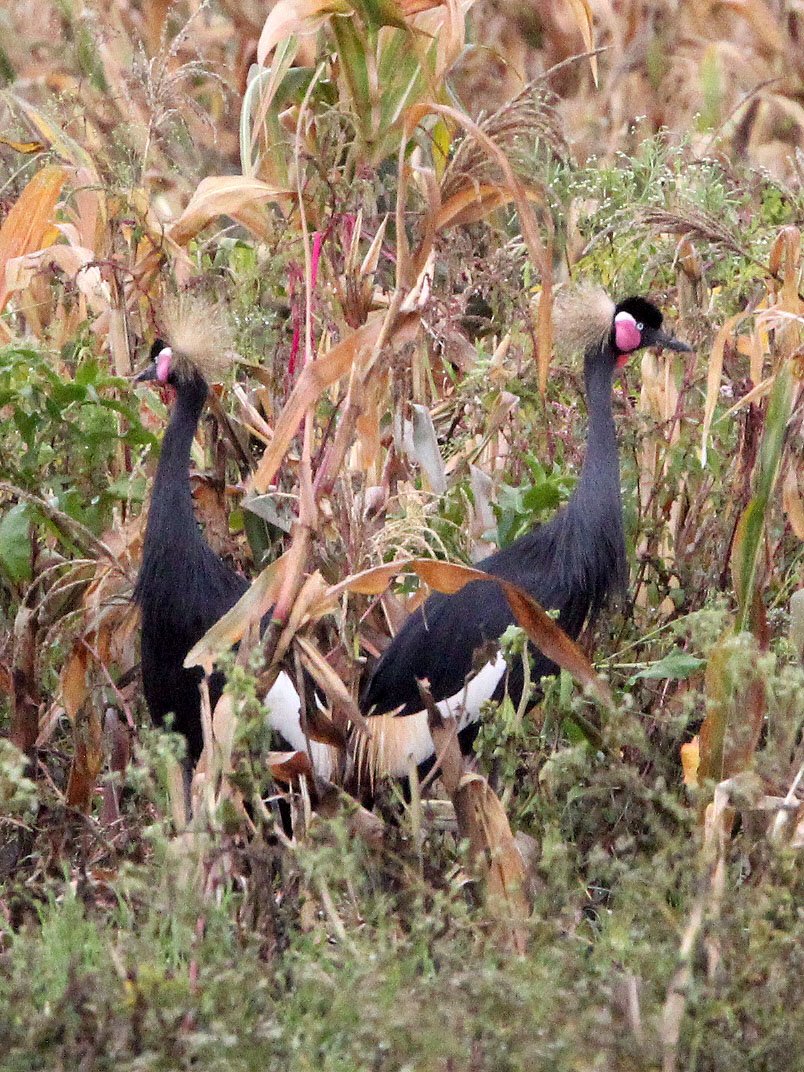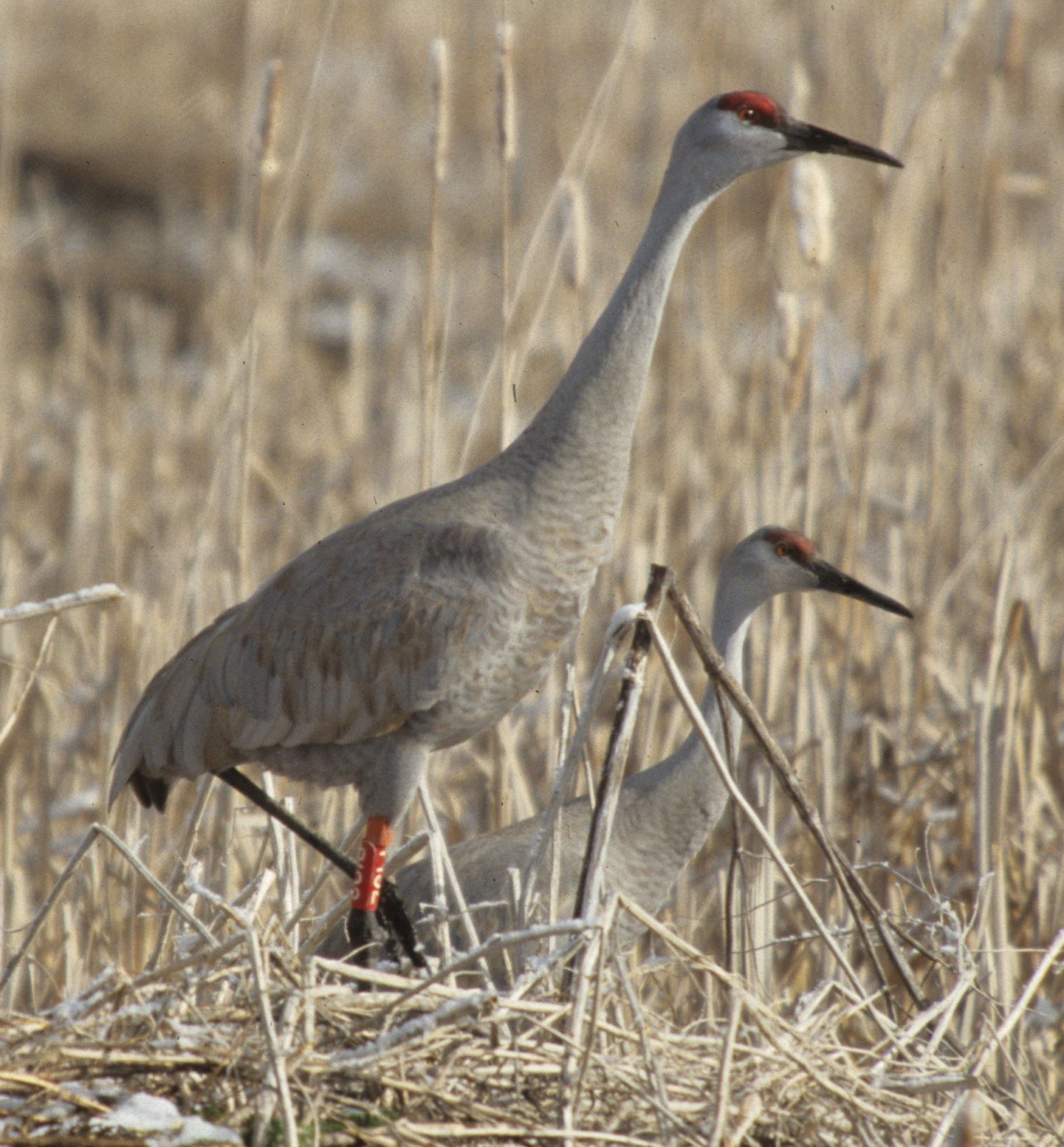
Family Gruidae, Cranes

Cranes are a family, the Gruidae, of large, long-legged, and long-necked birds in the group Gruiformes. The 15 species of cranes are placed in three genera, Antigone, Balearica, and Grus. Unlike the similar-looking but unrelated herons, cranes fly with necks outstretched, not pulled back. Cranes live on most continents, with the exception of Antarctica and South America.
Courtship between pair of Western Sarus Cranes in Gujarat, India
They are opportunistic feeders that change their diets according to the season and their own nutrient requirements. They eat a range of items from small rodents, eggs of birds, fish, amphibians, and insects to grain and berries.
Cranes construct platform nests in shallow water, and typically lay two eggs at a time. Both parents help to rear the young, which remain with them until the next breeding season.
Some species and populations of cranes migrate over long distances; others do not migrate at all. Cranes are solitary during the breeding season, occurring in pairs, but during the nonbreeding season, most species are gregarious, forming large flocks where their numbers are sufficient.
Most species of cranes have been affected by human activities and are at the least classified as threatened, if not critically endangered. The plight of the whooping cranes of North America inspired some of the first US legislation to protect endangered species.
The cranes have a cosmopolitan distribution, occurring across most of the world continents. They are absent from Antarctica and, mysteriously, South America. East Asia has the highest crane diversity, with eight species, followed by Africa, which is home to five resident species and wintering populations of a sixth. Australia, Europe, and North America have two regularly occurring species each. Of the four crane genera, Balearica (two species) is restricted to Africa, and Leucogeranus (one species) is restricted to Asia; the other two genera, Grus (including Anthropoides and Bugeranus) and Antigone, are both widespread.
Many species of cranes are dependent on wetlands and grasslands, and most species nest in shallow wetlands. Some species nest in wetlands, but move their chicks up onto grasslands or uplands to feed (while returning to wetlands at night), whereas others remain in wetlands for the entirety of the breeding season. Even the demoiselle crane and blue crane, which may nest and feed in grasslands (or even arid grasslands or deserts), require wetlands for roosting at night. The Sarus Crane in south Asia is unique in having a significant breeding population using agricultural fields to breed in areas alongside very high density of humans and intensive farming, largely due to the positive attitudes of farmers towards the cranes. In Australia, the Brolga occurs in the breeding areas of Sarus Cranes in Queensland state, and they achieve sympatry by using different habitats. Sarus Cranes in Queensland largely live in Eucalyptus-dominated riverine, while most Brolgas use non-wooded regional ecosystems that include vast grassland habitats. The only two species that do not always roost in wetlands are the two African crowned cranes (Balearica), which are the only cranes to roost in trees.
Some crane species are sedentary, remaining in the same area throughout the year, while others are highly migratory, traveling thousands of kilometres each year from their breeding sites. A few species like Sarus Cranes have both migratory and sedentary populations, and healthy sedentary populations have a large proportion of cranes that are not territorial, breeding pairs.
I have somehow managed to see all fifteen species of cranes in their natural habitat. To see the fruits of this accomplishment, follow the links on the images below!

Red-crowned Crane (Grus japonensis), Japan & East China
Sarus Crane (Antigone antigone), India & Thailand
Black-necked Crane (Grus nigricollis) Yunnan, China
Black-crowned Crane (Balearica pavonina) Ethiopia
Grey-crowned Crane (Balearica regulorum) East Africa
Blue Crane (Grus paradisea) South Africa
Sandhill Crane (Antigone canadensis) Western North America, CA, OR
White-naped Crane (Antigone vipio) Poyang Lake, China
Whooping Crane (Grus americana) Texas, USA
Hooded Crane (Grus monacha) Poyang Lake, China
Demoiselle Crane (Grus virgo) India
Siberian Crane (Leucogeranus leucogeranus) Poyang Lake, China
Brolga (Antigone rubicunda) Northern Territory, Australia
Wattled Crane (Grus carunculata) Botswana & Ethiopia
Common Crane (Grus grus) Eurasia in many locations
















